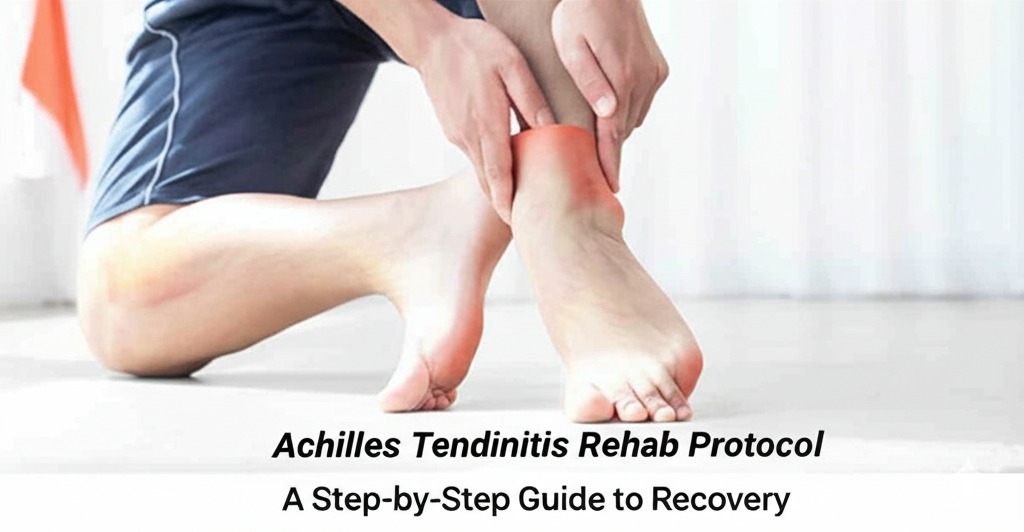Introduction
Achilles tendinitis is a common overuse injury that affects athletes, runners, and active individuals. It occurs when the Achilles tendon—the thick band of tissue connecting the calf muscles to the heel bone—becomes inflamed due to repetitive stress. If left untreated, it can lead to chronic pain and even a rupture.
Recovering from Achilles tendinitis requires a structured rehabilitation protocol that focuses on reducing pain, improving mobility, and strengthening the tendon. In this guide, we will walk you through an effective rehab plan to help you get back on your feet safely and efficiently.
Understanding Achilles Tendinitis
Causes and Risk Factors
- Overuse and repetitive stress from activities like running or jumping
- Sudden increase in activity level or intensity
- Tight calf muscles that strain the tendon
- Poor footwear that lacks proper support
- Flat feet or high arches that alter foot mechanics
Common Symptoms
- Pain and stiffness in the Achilles tendon, especially in the morning
- Swelling and tenderness along the tendon
- Pain that worsens with activity and improves with rest
- Thickening of the tendon in chronic cases
Achilles Tendinitis Rehab Protocol
Phase 1: Pain and Inflammation Management
The first step in rehabilitation is to reduce pain and inflammation while allowing the tendon to heal.
Rest and Activity Modification
- Avoid activities that aggravate the tendon, such as running or jumping.
- Engage in low-impact exercises like swimming or cycling.
Ice Therapy
- Apply an ice pack to the affected area for 15-20 minutes every 2-3 hours.
- Helps reduce swelling and numb pain.
Compression and Elevation
- Use a compression wrap to minimize swelling.
- Elevate the foot above heart level to reduce inflammation.
Pain Management
- Over-the-counter anti-inflammatory medications (e.g., ibuprofen) can help with pain relief (consult a doctor before use).
Phase 2: Stretching and Mobility Exercises
Once the pain subsides, the next step is to restore flexibility and mobility in the Achilles tendon.
Calf Stretching
- Stand facing a wall, place one foot behind the other, and keep the back leg straight.
- Lean forward until you feel a stretch in the calf.
- Hold for 20-30 seconds, repeat 3-4 times per day.
Seated Towel Stretch
- Sit with your leg extended, loop a towel around the ball of your foot.
- Gently pull the towel to stretch the Achilles and calf.
- Hold for 20 seconds, repeat 3 times.
Phase 3: Strengthening Exercises
Strengthening the muscles around the Achilles tendon is crucial for preventing re-injury.
Eccentric Heel Drops
- Stand on a step with your heels off the edge.
- Slowly lower your heels below the step, then return to the starting position.
- Perform 3 sets of 15 reps daily.
Toe Raises
- Stand with feet hip-width apart.
- Raise up on your toes and slowly lower down.
- Do 3 sets of 12 reps.
Resistance Band Exercises
- Use a resistance band to add tension while performing foot flexion and extension exercises.
- Helps strengthen the Achilles tendon and surrounding muscles.
Phase 4: Gradual Return to Activity
After regaining strength and flexibility, it’s time to gradually reintroduce activity.
Low-Impact Cardio
- Start with non-weight-bearing exercises like swimming or cycling.
- Progress to brisk walking before attempting running.
Progressive Running Program
- Begin with short, slow jogs on soft surfaces.
- Increase intensity and duration gradually to avoid re-injury.
Proper Footwear and Support
- Wear shock-absorbing shoes with proper arch support.
- Consider using heel lifts or orthotics if recommended by a specialist.
Preventing Achilles Tendinitis Recurrence
To prevent future issues, focus on maintaining strong and flexible muscles. Here are some key strategies:
- Regular stretching and strengthening of the calves and Achilles tendon
- Gradual progression in training intensity to avoid sudden overload
- Cross-training with low-impact activities to reduce repetitive stress
- Listening to your body and addressing pain early
Conclusion
Recovering from Achilles tendinitis requires patience and consistency. Following a structured rehab protocol can help reduce pain, restore mobility, and strengthen the tendon to prevent recurrence. Always listen to your body, and if pain persists, seek professional guidance from a physical therapist or sports medicine specialist.
If you’re dealing with Achilles tendinitis, start your rehab today and take the first step towards a pain-free, active lifestyle!

Kallie Snyder is an author at Stonegate Health Rehab, providing valuable insights, recovery guidance, and rehab resources to help individuals achieve better health and well-being.
